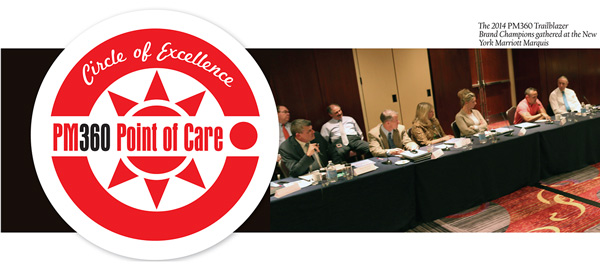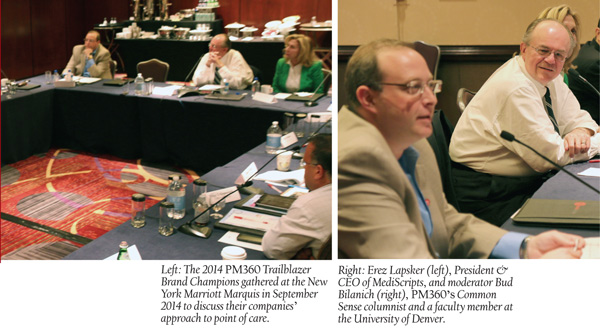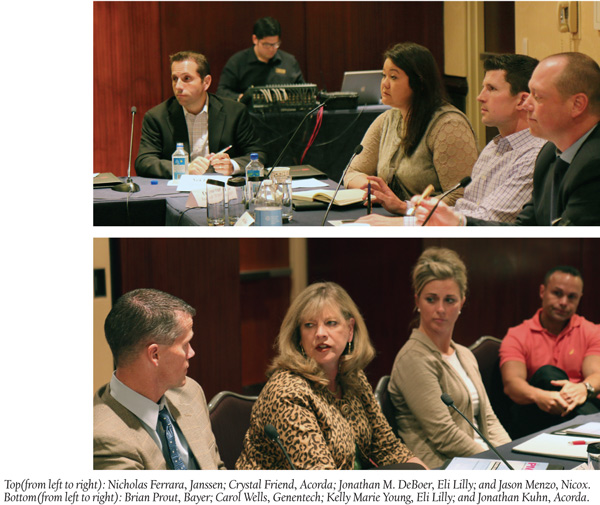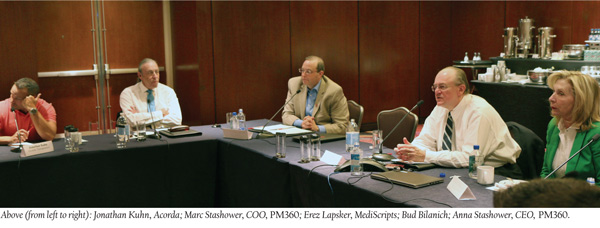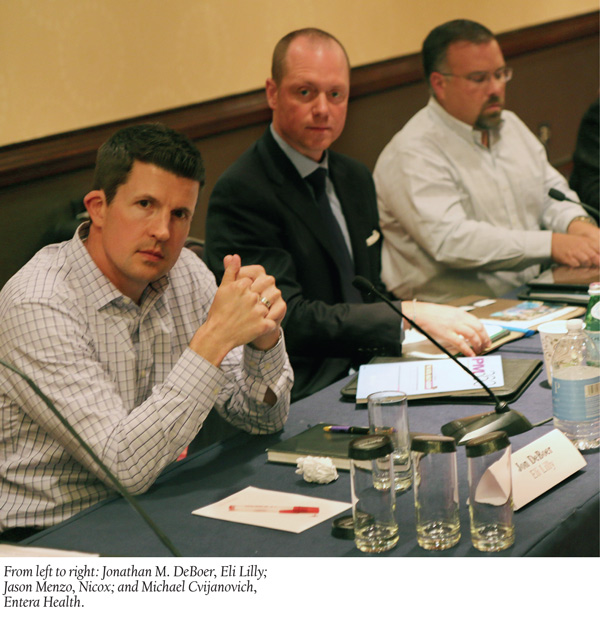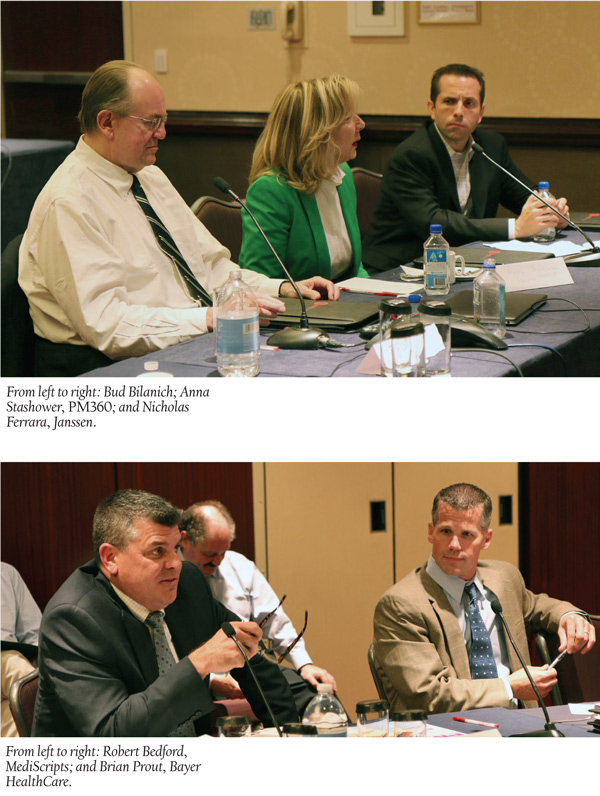Nine PM360 Trailblazer Brand Champion Award Winners joined us just before last year’s awards gala to discuss point of care marketing. PM360’s Common Sense Columnist, Bud Bilanich, moderated. Participants included:
Michael Cvijanovich
VP, Marketing, Entera Health
Jonathan M. DeBoer
Associate Brand Manager, Eli Lilly & Company
Nicholas Ferrara
Product Director, Immunology, Janssen Biotech
Crystal Friend
Associate Director, CNS Marketing, Acorda Therapeutics, Inc.
Jonathan Kuhn
Senior Director, Global & Brand Marketing, Acorda Therapeutics, Inc.
Jason Menzo
Senior Director, Head of Marketing & Operations, Nicox Opthalmics
Brian Prout
Deputy Director, Betaseron Marketing, Bayer HealthCare Pharmaceuticals Inc.
Carol Wells
Senior Director, Commercial Training and Development, Genentech
Kelly Marie Young
Brand Manager, HCP Marketing, Eli Lilly & Company
PM360’s Point of Care Circle of Excellence was sponsored by MediScripts. MediScripts participants included Erez Lapsker, CEO and Robert Bedford, EVP, Sales & Marketing.
Bud Bilanich: We’re all here today to talk about point of care marketing. So I’d like to ask everyone this question to start: What point of patient care channels are you using? What are you finding effective, and why?
Brian Prout: We use everything from print to digital to video media in the pharmacy, in the waiting room, and to get information into the doctor’s hand. From an ROI standpoint, the print and the ePrescribing side are most effective. But our strength comes from targeting the right prescribers.
So it’s not simply about matching your target list, but also, in instances when our investments are a little tight, we ensure we’re targeting the doctors our field force does not have access to—because these physicians don’t have an option, or their patients don’t. If they’ve opted into the media, we are able to reach out to them at the point of care, whether it’s in a local pharmacy or in the waiting room.
Bud Bilanich: Jon, how about at Acorda?
Jonathan Kuhn: A good example of how we use point of care marketing: We employed a point of care for Zanaflex capsules. One of our biggest challenges was drug switching at the pharmacy level, even though the drugs were not AB equivalent. We responded by creating a patient bill of rights to inform them that the pharmacist should not switch the medication. So if patients were filling one of their asthma medications, we reminded them when they were in the pharmacy filling in for Zanaflex. That was not only done at the point of care, but also at the point of purchase—and was very effective.
Bud Bilanich: Did you work with the physicians on that in terms of dispense as written?
Jonathan Kuhn: Yes, we kept the physicians informed as well. We used MediScripts prescription pads and reminded physicians on every fifth prescription that if they wanted to use Zanaflex capsules, they had to write: Zanaflex capsules, dispense as written.
Bud Bilanich: Did you measure the ROI?
Jonathan Kuhn: Yes, we measured versus a control group that was not getting the advertisement reminders to gauge the effect. We found a significant change in behavior.
Bud Bilanich: Nick, what channels work for you?
Nick Ferrara: Ultimately, the waiting room and the exam room are ideal for messaging. Depending on the brand, what has been effective is providing patient materials, particularly from a website, to help guide them in discussions with the physician. Some disease states are more challenging for patients to discuss—so we give patients those tools.
As a result of compliance, space challenges, and all of the competition within those spaces, it has become so noisy that differentiating your product is a real challenge. But leveraging that to the next level, in terms of digital and potentially mobile type applications, I think, is the wave of the future.
Bud Bilanich: Crystal, which channels are most effective for you?
Crystal Friend: They all are. It’s up to marketers to identify what the business need is because that defines which channels are used. It’s going to define which aspect of segmentation you look at—and what the priority is. We look to partners, such as MediScripts, to help us identify where we can use tools in different channels that align with our business needs.
Bud Bilanich: So the upshot: A lot of opportunity is available for marketers inside companies to work with suppliers and engage in a dialogue that sparks interesting and new ideas that neither side alone might have originally come up with.
Crystal Friend: Yes. It’s a partnership—and has to be. We know the strategy and business objectives. You see the utility and success of the tool in terms of how it is used as a best practice across industry. So sharing that and engaging in dialogue helps us identify which tool or resource is going to be effective in the channel that we’re trying to penetrate.
Erez Lapsker: Right. And the amazing thing is that we are developing those tools, which are the vehicles that enable you to sit at the table between the HCP and the patient and have that dialogue.
Bud Bilanich: Jon, what is your experience with the effectiveness of the various channels?
Jon DeBoer: As Crystal said, all channels are effective depending on your brand and what you want to accomplish. I don’t know if I’d call point of care a challenge, but there are certain table stakes that we all have in terms of where we invest marketing dollars—because everybody’s doing it. It is simply entrance to the game. It’s very risky to decide to take your brand and spend dollars in a completely different direction.
We all think about how to keep our brands top of mind with physicians and patients. If we can help physicians with a patient at that moment of truth—at diagnosis—and we can help in that unbranded space through point of care, we will be seen as a trusted provider.
Bud Bilanich: Jason, what works best at Nicox?
Jason Menzo: At Nicox, our products are point of care products. They are laboratory-developed tests used in the exam room and in the office. So everything we’re discussing is relevant to what we do because there is no pharmacy that the patient goes to. We win in the exam room.
The way we’ve approached this: We look at the point of care as a journey that starts with everything that happens from the moment the patient walks in the front door to the moment they walk out. Having a system that is integrated is important and messages must be tailored each step of the way.
Most importantly, though, as Nick noted, noise exists in each specialty. Every exam room and waiting room has a thousand patient-facing brochures that show people walking on the beach with their golden retriever. They all have the same look and feel. So we have to win by providing materials that are engaging, stand out and are different. It’s not necessarily about providing bold or emotional creative, but providing something that grabs the patients, engages them and causes them to pick up that brochure.
Bud Bilanich: And again, I think that’s something that relates to becoming a trusted provider. Mike, do you have anything to add?
Mike Cvijanovich: From the smaller budget side, we are challenged with the need to be very surgical about everything we do. By doing a lot of surgical micro-targeting on the patient side, I can get information or educational materials and conversation guides to them.
We’ve had success with educational materials, but not over the top branded materials because physicians and patients see right through it. But giving doctors something they can see the value in and can use to teach their patients—that helps builds trust.
Carol Wells: Trust is important. One of the things I love about being part of Genentech is its patient and science focus—which starts at the top. The focus is on the right patient getting the medication when they need it. That attitude permeates our whole organization. Building trust starts with that.
Jonathan Kuhn: It’s also goes beyond providing disease education to finding out just what the patient wants. For example, MS patients may just want exercise tips for their particular stage in the disease’s progression. One of the first resources we produced in the MS area is the MS Resource Guide. It has nothing to do with product, but instead is a reference guide for people who would typically go into denial upon diagnosis and often go for a second and third opinion.
But when the diagnosis finally sinks in, people panic, go online and research—but there’s too much information. So we provided a one-stop resource guide that allowed patients to find the information they need at that particular point. Sometimes point of care is more focused on finding out what patient interests and wants are as they’re dealing with the disease. That’s another way of building trust as well.
Bud Bilanich: Kelly, how do you view this?
Kelly Marie Young: Creating trust is something we all agree is very important, especially in the non-face to face space. If you’re going to connect with HCPs, you need to have that. How do you earn HCP trust? Most likely by providing the content they expect in the channels they prefer when they are there.
Something I am working on understanding: How do I get to that spot within my segment that provides clear insight into how customers are reacting to the content I serve up. And then, how I can continue to optimize and customize based on my learning?
Erez Lapsker: That’s where one of the unique properties of our clinical search engine can help. When a doctor is trying to find information for a patient or himself, we serve up curated or sponsored content as well as ad messaging. But we don’t consider it to be advertising—it is all content. And every bit is important and relevant to what the physician is seeking.
For instance, if the physician is searching for information and background for a diabetic patient and that information comes up in the search, advertising comes up with it as well—but it comes up in the same context as everything else. So any message you want to be delivered at that moment to that targeted doctor can happen, but it is definitely a challenge.
Bud Bilanich: Because it is non-promotional by nature, curated content helps to build the trust we’ve been discussing. But how do you do that if you are on the company side trying to sell a product?
Erez Lapsker: It’s about how it’s laid out in the format. When the doctor is looking through information, your information comes up in the same delineation as everything else, including the trusted resources. Because it’s part of that context, you instantly become part of the reliable source.
Bud Bilanich: Crystal, what are your thoughts on building trust?
Crystal Friend: Using unbranded awareness to help build trust is something that absolutely holds a responsibility to educate patients and physicians on the disease states that we treat. In thinking about how we leverage unbranded tools—it is not just whether we use unbranded or branded materials—sometimes, it’s about the timing and the placement. That is where point of care channels and tools really become important.
Erez mentioned curated content and in areas where it works, absolutely use it—you don’t have to get caught up in branded or unbranded messages. It becomes about positioning and making sure that curated content supports the dialogue—then bringing sales on board. It all works together. We get the patient into the office—you just have to ensure that that product is top of mind when the time is right.
Rob Bedford: Absolutely right. Today the technology is so good that we can tie that content and what is served to the clinical search terms they are using and the discussions they are having with their peers about product so that appropriate messages will be served based on what they are talking about, or what they are interested in learning about.
Bud Bilanich: How are others here helping to build that trust?
Carol Wells: We recreated the journey of a breast cancer patient in a walking tour through several rooms that symbolized each step from the time that she discovered a symptom or a lump, when she heard the diagnosis, and all the way through to two years out. We, and the patients, walked that journey.
As people experienced emotions or felt that something might be missing in their care, they placed sticky notes on a designated wall. We wanted to identify gaps in that patient experience from the first suspicion of disease to two years post-treatment and identify where we could come in and help.
We found two areas. One was after the first visit when the patient heard essentially nothing of what the doctor said about treatment options, but heard only, “You have cancer.” We then found we could help in the second year when family, friends and all the best-intentioned people drifted away while this person was still on their journey.
It was really interesting to try to put yourself in the shoes of patients, listen to them and then identify the gaps in what is really important to the patient and what the patient wants and needs now—rather than duplicate other things already available.
Bud Bilanich: So this was done for the people in the company, the marketers, to help develop empathy for the patient and then find the areas where the patient was underserved.
Carol Wells: Exactly. Patients walked the experience, too, and we were able to find out if it rang true, what patients found that was or was not available to them at various times and what they would have preferred to have. We wanted to learn how to close the gap and become a trusted partner to these patients.
Brian Prout: Right, so when you are serving that patient two years later after their family support system may have tapered off, you’re going in from a genuine patient support perspective. You are not promoting the product at that point. Instead, you are asking, “How else can we help you?”
Jason Menzo: Yes, and in terms of building trust, one of our products is for a disease state called Sjogren’s syndrome and we work very, very closely with the Sjogren’s Syndrome Foundation. We leverage that partnership because we want to educate—in partnership—with the foundation. It’s not leveraging patient advocacy, however, but leveraging the goodwill of partnering with another organization.
Bud Bilanich: So the point of care has a lot to do with trust building, and building trust has a lot to do with demonstrating that you care.
Mike Cvijanovich: Well, yes. It comes down to trust—and credibility. We’re a very scientifically oriented company and one of the challenges is getting folks to realize where doctors find value: In having the conversation and being able to ask questions. Nobody wants to listen to a didactic presentation.
The adult attention span is about 30 seconds—or less. So marketers better have something that’s interactive, grabs attention and engages—not just for the doctor but also for the patients, to give them what they want, too. And if you say you’re going to provide something when they click on the website—that needs to be exactly what is served up. Nothing else.
Also, if you ask customers for permission, they generally respond positively. But if you’re trying to force things on them, the results don’t come.
So in deciding when to switch from the unbranded or disease-state education to more branded materials, you might simply ask if they would be interested in receiving it. If they are not interested, that’s fine. But asking—and then respecting their wishes—can go a long way.
Erez Lapsker: Yes, these things can make a big difference. I want to add something: The field of nurse practitioners is one of the largest growing populations of prescribing professionals, but from what I’ve heard from pharma, nurse practitioners are not on the radar. I’m curious to see if there’s any interest in being able to reach out to this large population—who prescribe your drug.
Kelly Marie Young: I think it probably depends on the therapeutic area. We would probably all acknowledge that this is definitely a growing segment of prescribers over time.
Jason Menzo: In eye care, there are no nurse practitioners or PAs, but the parallel are optometrists and ophthalmic technicians. The difficulty is that they are super influential. They are the decision makers in many cases and they do the work up and decide how to manage the patient. But there is simply no mass way to identify and talk to them. No national associations exist. So that’s a challenge.
Bud Bilanich: Well, I think we’re back to where we started. Basically, people are saying that defining point of care is difficult. I think pharmacy is particularly challenging.
Jonathan Kuhn: Yes. The question is: How do you help the pharmacists? How does the pharmacist become loyal to you? Their loyalty is to the patient and that concerns price and clinical safety, correct?
Nick Ferrara: I started my career in what we called pharmacy affairs or pharmacy marketing—and the profession has changed. You now have pharmacists at the retail level, hospital pharmacists and multiple pharmacists at various specialty pharmacies. So I have been fighting this battle for a long time—especially with our brand marketing teams. They are very focused on the individual or individuals who generate the script. And I get that—it’s definitely the number one priority.
But my argument is this: Your pharmacist needs to be your advocate. So if the patient asks the pharmacist a question, you don’t want her to look like a deer in the headlights. Instead, you want the pharmacist to be educated—to feel comfortable speaking about your brand in terms the patient can understand. So that’s always been our good fight.



